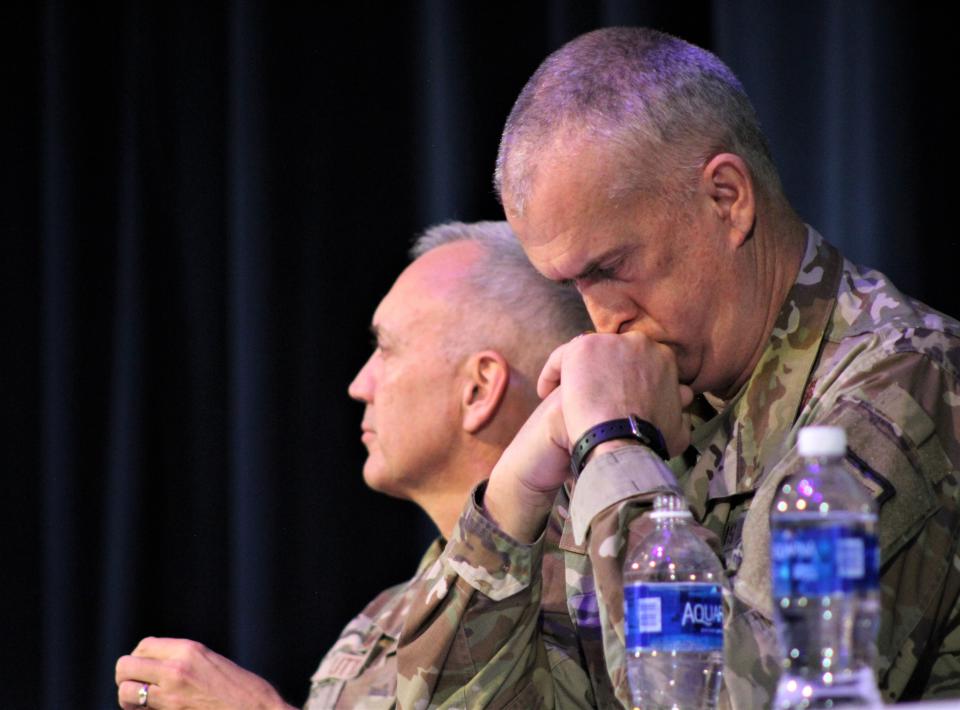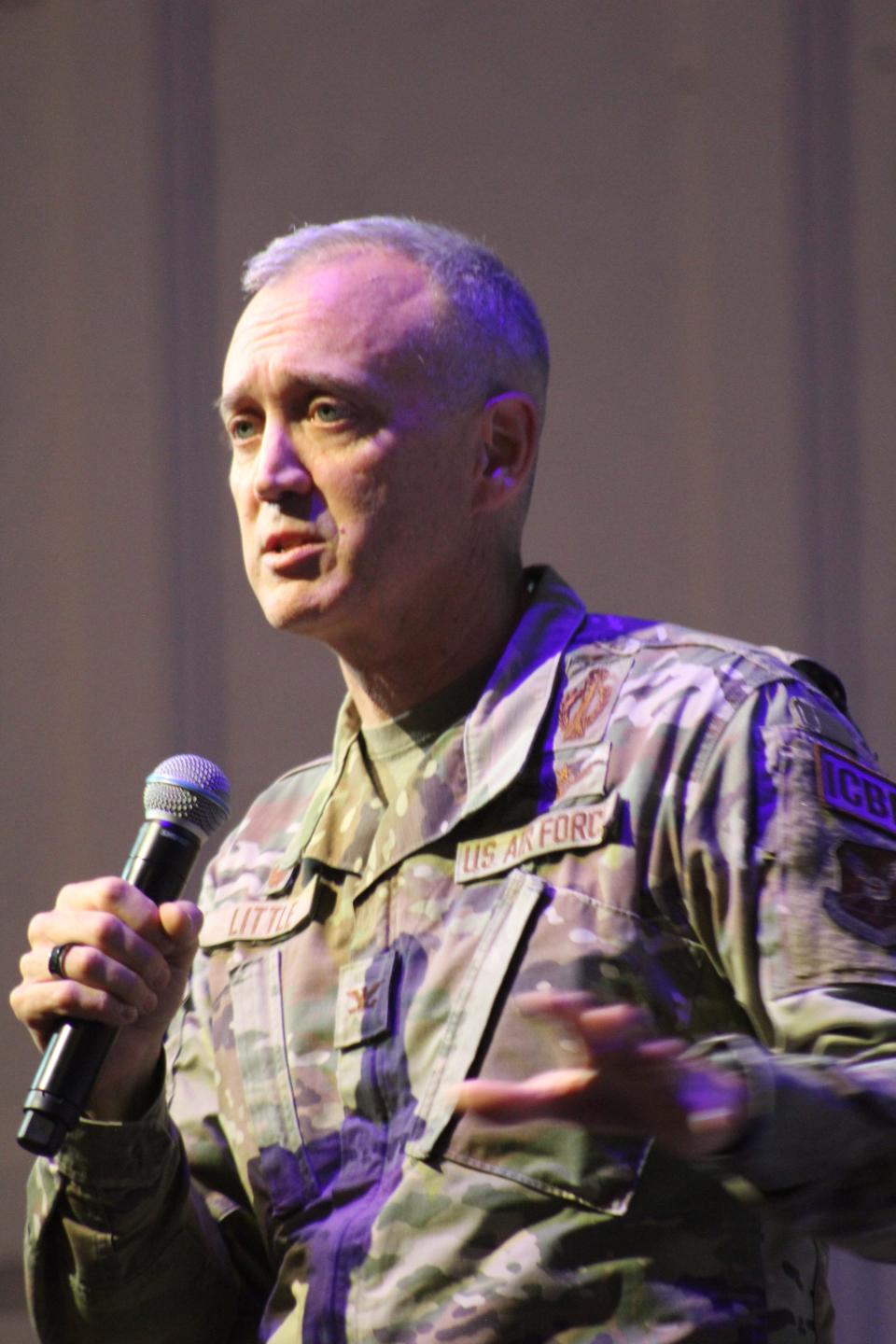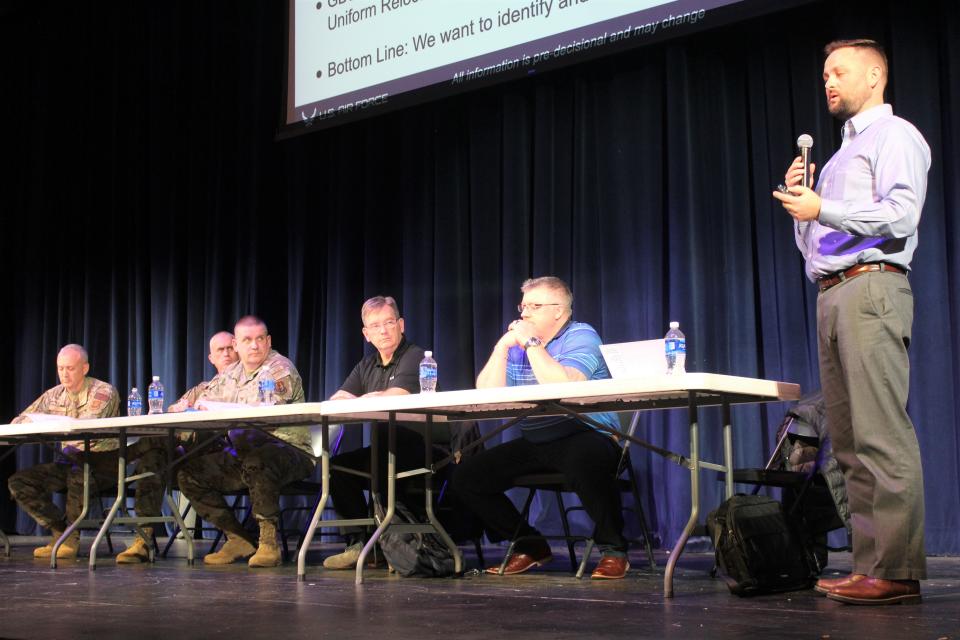What does the Sentinel Missile Project mean for central Montana?

A near capacity audience filled the Davidson Family Auditorium at Great Falls High School Thursday night to learn the details of the impending Sentinel ICBM (Intercontinental Ballistic Missile) conversion project. The U.S. Air Force is now just a few years away from launching into the $180 billion effort to replace the aging Minuteman III ICBM system that was activated more than 60 years ago.
“We’re modernizing because we have an old system called Minuteman III,” explained Brigadier General Colin Conner, Director of ICBM Modernization. “It’s been in the ground since 1962, and while we’ve made changes to it … the time has been reached that we have to put a new system in the ground. That’s Sentinel. It’s 150 launch facilities, eight launch centers, and then a variety of military construction projects on the base (Malmstrom Air Force Base). We’re going to basically refurbish everything that you see.”
“We don’t live in the great peaceful environment that we would all hope for,” Conner added. “We have potential adversaries in Russia and China. They are growing their nuclear enterprise, and while we would like to say the Minuteman could do it all, we’ve got to remain competitive in this environment from a national security perspective.”

Montana and the ICBM installations central Montana hosts is only a portion of the modernization effort. Gen. Conner told the audience that the first phase of the Sentinel Project will begin in Wyoming, focused around F.E. Warren Air Force Base in Cheyenne. That launch will likely begin in 2026. The project is scheduled to move its center to central Montana in or around 2030 and will remain here for approximately five years. Then the project will move on to Minot Air Force Base in North Dakota.
“The way I like to describe this project is big – really big,” said Col. Charles Clegg, Director of the Sentinel Program Office out of Hill Airforce Base in Mountain View, Utah. “It is a complete replacement of the Minuteman III – the launch facilities and the launch centers. Also, we will be replacing the communications lines that are existing out there right now.”
Close to 3,000 construction personnel are expected to begin arriving in central Montana six years from now. To accommodate those temporary residents the Air Force plans to build two “workforce hubs,” one in Great Falls and one in Lewistown.
“The workforce hubs will be a 50- to 60-acre parcel that we will acquire where we’ll build housing, a small clinic, a grocery store - that sort of thing,” said Northrup-Grumman aerospace and defense corporation representative Matt Dillow. “The folks that we don’t hire locally will live right there. They aren’t likely to be bringing in their families and children, so we don’t expect our workforce to have much of an impact on school districts.
“Our approach to the housing is to build that workforce hub to provide the housing so they’re not putting pressure on the local housing market.”

Dillow acknowledged that the sudden influx of so many workers will likely have an impact on central Montana’s healthcare systems.
“Obviously, you can’t bring that many folks into a community without imposing some sort of burden on the healthcare system,” Dillow said, “but we do intend to provide our own basic healthcare sites at an urgent care level within the Workforce Hubs themselves.”
Once the Sentinel Project is completed, these Workforce Hubs will either be demolished, and the land returned to its original condition or could potentially be turned over to community stakeholders to be used for some alternative purpose.
A major component of the Sentinel Project will be the replacement of the current electrification and communications infrastructure. Taylor Walton, the Sentinel Project’s real estate acquisitions lead said the Air Force will seek to replace above ground systems composed of poles stretching power lines across the landscape with buried lines – many of which will require permanent easements across private lands.
“The first interaction you might have with this project is negotiating with the Army Corp of Engineers,” Walton told the audience. They have been tasked with negotiating with types of landowners. We will also have the Air Force Engineering Center out of San Antonio, Texas working with local municipalities to establish the necessary rights that we need to construct across roads, railroads and other land owned by the public.”
“We will also be acquiring property outright to establish some new power sites, he added. “We’re talking about approximately 1,800 miles of corridors that need to be constructed. Right now, we’re evaluating where those new easements need to be in place and where those new utilities will be installed. Generally speaking, they will be installed to a depth of between three- to eight-feet using a variety of construction techniques.
“We also have approximately 32 new tower sites that will need to be acquired. Those sites are going to be approximately five-acres in size and will support a 300-feet tower. We’ll need a right of entry to allow us to get to that site, so there will be a permanent road that allows us to get to that site as well.”

Following the Air Force presentation, the audience asked a series of questions of Air Force officials.
Will the modernization of the nation’s ICBM’s start an arms race?
“We’re not building additional ICBMs,” replied Col. Barry Little, Commander of the 341st Missile Wing at Malmstrom. “We’re not adding anything, we’re simply replacing what we currently have. We will adhere to the treaties that we are already partners of and will follow those treaty guidelines. From that perspective it’s the status quo.”
Will the Air Force sign a Project Labor Agreement with local labor unions to ensure that work on the Sentinel Project is being done by Montanans?
“Our primary construction contractor will be Bechtel Engineering Company,” said Matt Dillow. “They work closely with unions regularly on construction projects they’re engaged in across the country. We’re not at the point yet where we are sourcing the labor for the project. We will follow directions from the federal government on what sort of labor agreements we are beholden to.”
Will there be a new Fighter Wing stationed at Malmstrom AFB?
“I’m sorry – no,” Col Little said bluntly. “We do not have a control tower on base, and the tanks on base that support the tanker mission and previously the fighters are not in a condition to be used again. It would take a tremendous amount of money to put the base into a position where it would be safe to fly aircraft out of it again.”
Little added that from an economic standpoint what the Sentinel Project will do will be to ensure that the Air Force’s mission in central Montana will continue for decades to come.
“This is a foundational element of the nuclear triad that will last until 2075,” he said of the Sentinel Project’s importance to the region. “What you’re looking at is a fundamental investment in Montana and the future defense of our country. It’s an essential capability that will last long into the future.”
What provisions will there be to maintain community and county roads impacted by additional Air Force traffic?
“We are working with Northrup-Grumman to evaluate and survey we would like them to utilize during the construction activities,” said Walton. We will couple that with our design for conversion of the launch and missile alert facilities to make sure we have a clear understanding of the types of trucks and equipment that we’re going to be hauling on these roads.
We want to be a good member of the community and we will be coming to the organizations that own all these roads and working through a solution. What I would anticipate is we will have a baseline assessment of what that road looks like prior to construction, and then we will look to maintain that same level of service on that road because we are all going to be utilizing them at the same time.
We’re probably several years away from being able to pull everything together and then start talking to the different municipalities and organizations that own those roads. Our intent is that we would then make that a public process.”
In just a few years the Sentinel ICBM conversion project will come to central Montana. It’s ultimate effects remain to be seen, but there can be no doubt it will have a long-lasting effect on the cultural and economic landscape in which we live.
This article originally appeared on Great Falls Tribune: U.S. Air Force speaks to public about Sentinel ICBM project

